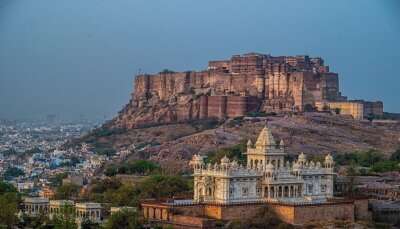Take A Spiritual Journey To Trinetra Ganesh Temple Ranthambore In 2026

One of Rajasthan’s most popular pilgrimage destinations is Trinetra Ganesh Temple Ranthambore, located in the famous Ranthambore Fort. This is the only temple worldwide where Lord Ganesha is worshipped and depicted with three eyes, signifying his omniscience. This temple draws thousands of devotees and tourists every year, not only for its religious importance but also for its unique location amidst the ruins of a fort and surroundings that comprise the Ranthambore National Park. Devotees from all parts of India and the locals living nearby visit this temple.
About Trinetra Ganesh Temple Ranthambore
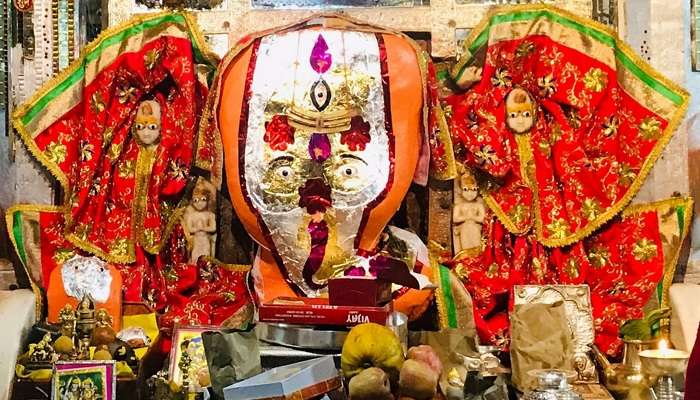
The main attraction is the deity of Lord Ganesha. Devotees coming to Trinetra Ganesh Temple Ranthambore believe their wishes will be fulfilled after visiting this place. This temple is a centre of spiritual activity, especially during festivals such as Ganesh Chaturthi, when it comes alive with colourful celebrations and rituals. One of the most religious things you will encounter here is the daily Aarti ceremonies at dawn and dusk. This is the time when tourists can experience a serene and sacred atmosphere.
The Trinetra Ganesh Temple is within the Ranthambore Fort, on a hillock in the Sawai Madhopur district of Rajasthan. This UNESCO World Heritage site covers almost 4.5 square kilometres on a hill about 700 feet above the plain below.
Must Read: Places To Visit In Ranthambore
Architecture Of Trinetra Ganesh Temple Ranthambore
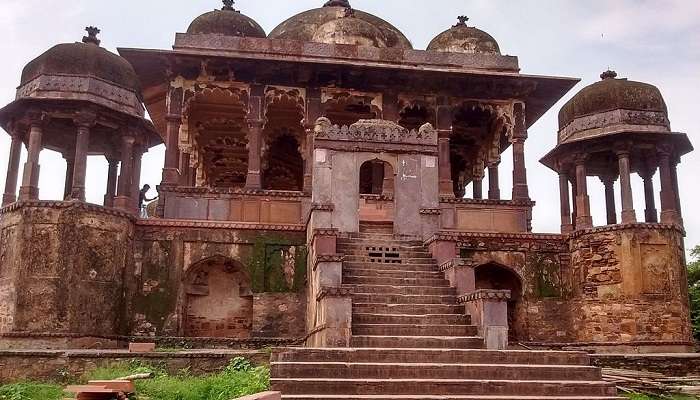
Trinetra Ganesh Temple dates back to the 13th century. According to popular stories, the temple was founded by King Hammir Dev Chauhan, a great devotee of Lord Ganesha. He prayed to Lord Ganesha for his victory before his kingdom was attacked. One day, Lord Ganesha came into his dream with three eyes and promised him success. After that, he found an idol of the deity in the fort and thus founded this temple to pay homage to him. The temple architecture displays the traditional Hindu temple pattern and the Rajputana structure. There is an idol of three-eyed Lord Ganesha, his wives Riddhi and Siddhi, and sons Shubh and Labh. The walls are intricately carved with decoration work, and some sculptures depict several mythological scenes.
Timing: 6:30 am To 8 PM
Top Attractions: Monuments and Wildlife
Nearby Attractions To The Temple
After reaching the entrance of the Ranthambore Fort, the Trinetra Ganesh Temple is reached by a short trek up the hill. The area surrounding Trinetra Ganesh Temple and Ranthambore Fort promises many interesting tourist spots that one should not miss while visiting this place. Here are some major attractions around Trinetra Ganesh Temple Ranthambore:
1. Ranthambore National Park

Home to many majestic animals – tigers- this is one of India’s most famous national parks. This is the place where tourists and celebrities love to come and see the wildlife of Rajasthan. It is a must-visit place for wildlife enthusiasts. You can take up Jeep and safaris here to see tigers in the wildlife. Tourists can also see leopards and other wild animals in their natural habitat. You can also see deer and various birds while on a journey to this national park. If you visit this place once, you will feel like coming back again and again to this majestic place.
Location: Just 1.5 km from Trinetra Ganesh Temple Ranthambore
Safari Time: 6.30 AM – 10.00 AM and 2.30 PM – 6 PM
Suggested Read: Places To Visit In Sawai Madhopur
2. Jogi Mahal
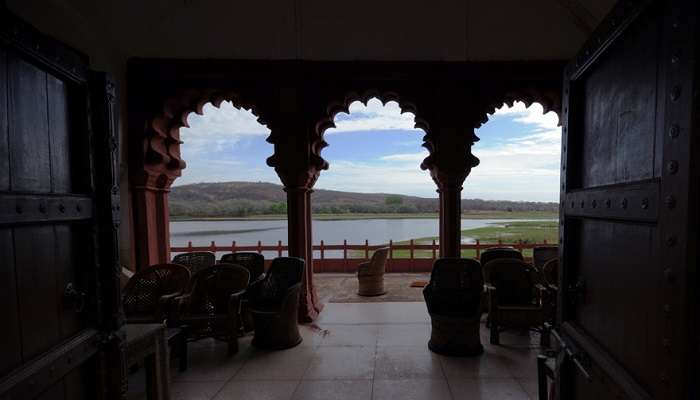
If you love to be in the forest and enjoy wildlife, such as tigers, monkeys, deer, and others, this is the ideal location. The lush greenery will leave you with no words to call this place – a natural paradise. Once a royal hunting lodge built by the kings of Jaipur, Jogi Mahal still stands within the national park, situated beside the Padam Talao, which has one of the largest lakes inside the park. Jogi Mahal is currently not open to the public. During the safari in the park, you can catch a glimpse of it. The area around Mahal has a huge Banyan tree, which is considered the largest in India. The lake view gives you several opportunities to see wildlife, which is otherwise rare to find anywhere else.
Location: Just 400 metres from Trinetra Ganesh Temple Ranthambore
Timing: Not open to the public
3. Rajiv Gandhi Regional Museum of Natural History
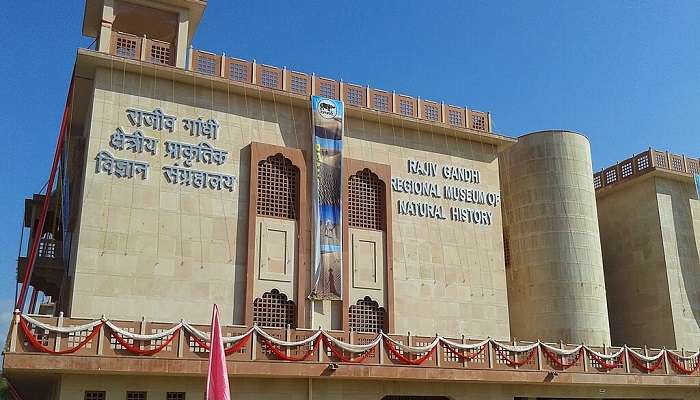
Rajiv Gandhi Regional Museum of Natural History is a well-known project tiger site in Ranthambhore. It is the fourth of its kind in India and joins others in Bhubaneswar, Mysore, and Bhopal. This museum sits in Rajasthan, sprawling over a land area of 7.2 acres. Having started operations in 2014, this museum operates under the Ministry of Environment, Forests, and Climate Change, with its primary mandate being to educate the masses about natural resources within the state of Rajasthan using exciting exhibits and interactive educational programs. The prominent galleries inside the museum will draw your attention as they highlight the wildlife inside the forest. You must visit this place if you travel with your family and children.
Location: About 8 km from Trinetra Ganesh Temple Ranthambore
Timing: From 9 AM to 6 PM
Suggested Read: Khaba Fort
4. Kachida Valley
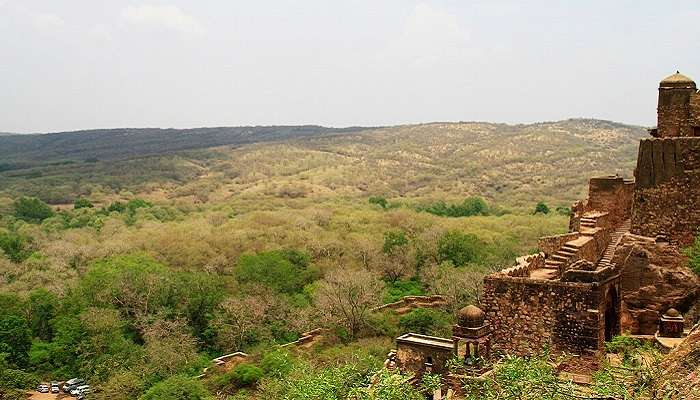
Lies close to the Ranthambore National Park, Kachida Valley boasts a vast population of panthers in this area, which can be seen moving right here to avoid conflicts with the tigers. One of the most rare sightings here is of sloth bears, who are often seen mostly near bee hives and ant hills. If you want to enjoy nature, you can take a jeep safari, walk inside the jungle, enjoy scenic beauty, and take rare pictures. Thick greenery, rocky outcrops, narrow hills, and stunning lakes collectively represent this valley. Your trip to Ranthambore is incomplete without visiting this place.
Location: About 12 km from Trinetra Ganesh Temple Ranthambore
Timing: From 5 AM to 7 PM
5. Amareshwar Mahadeo Temple

Located about 7 kilometers away from Sawai Madhopur, this is one of the ancient temples of Lord Shiva in Rajasthan. This ancient temple is surrounded by natural beauty and thus offers a peaceful retreat for visitors. Not many tourists visit this place as it is only known to a few frequent visitors or people living in Rajasthan. The natural beauty of the temple will draw your attention here. There is a pond near the temple that is often used for visitors to take a dip in the clean water. The sound of peacocks will make your day near the temple.
Location: About 8 km from Trinetra Ganesh Temple Ranthambore
Timing: From 6 AM to 7 PM
Suggested Read: Anokhi Museum of Hand Printing
How To Reach The Temple

Getting to the Trinetra Ganesh Temple Ranthambore involves travelling to the town of Sawai Madhopur, which is the gateway to Ranthambore. Here are the options:
By Train: Sawai Madhopur Railway Station connects decently to major cities like Delhi, Mumbai and Jaipur. The railway station is about 11 km from the fort. One can hire a taxi from the railway station or board the local buses, which will drop at the fort’s main entrance.
By Road: Most of the cities in Rajasthan and its surrounding states have road connectivity to Sawai Madhopur. Private cabs can quickly be hired or board the state-run buses.
By Air: The nearest airport is Jaipur International Airport, about 180 km from Ranthambore. One can take a taxi or train from Jaipur to Sawai Madhopur.
Further Read: Amber Fort Jaipur
The Trinetra Ganesh Temple in Ranthambore is much more than a worship place; it is among those places that offer a unique blend of spirituality, history, and natural beauty. Whether it is the quest for blessings, researching ancient ruins, or simply the associated rush with a wildlife safari, this temple and its surroundings have it all. The visit to Trinetra Ganesh Temple is an endless, deepening journey into the cultural and natural heritage of Rajasthan, etching an everlasting impression on visitors’ minds. So get ready to explore this place, and book your trip to Ranthambore now!
For our editorial codes of conduct and copyright disclaimer, please click here.
Cover Image Credit: THerrington for wikimedia commons
Frequently Asked Questions About Trinetra Ganesh Temple Ranthambore
What is the Trivia about Trinetra Ganesh Temple?
Trinetra Ganesh Temple is the only temple in the world where Lord Ganesha is depicted with three eyes. This form of lord Ganesha symbolizes his omniscience and divine vision.
What are the visiting timings to the Trinetra Ganesh Temple?
The temple is open from early morning to late evening, with fixed timings for the Aarti ceremonies. One should visit during these ceremonies to have a feel of the best spiritual atmosphere.
Are there any entry fees paid upon visiting the Ranthambore Fort and the Trinetra Ganesh Temple?
There are no entry fees to the temple itself. However, the entry fee charged for entering the Ranthambore Fort area is then used for its maintenance.
Which months are the best time to visit the Trinetra Ganesh Temple?
The best time to visit is during the winter, from October to March when the weather is good for sightseeing and wildlife safaris. You can also plan your visit during Ganesh Chaturthi; it will be worthwhile since you will be getting to experience the celebrations.
Can a visit to the temple and a safari in Ranthambore National Park be clubbed together?
Yes, many visitors will want to try to visit the temple and go on a safari, too, within this national park, hence getting both the spiritual and natural beauty of the area. It is highly advisable to book safaris in advance to avoid last-minute rush due to very high demand.
People Also Read:
Sri Chakra Mahameru Temple Kanipakam Vinayaka Temple Devalsari Temple

We all have to begin somewhere. This is where I start and I hope that my writings encourage you to begin. To new beginnings and conquering new places!





